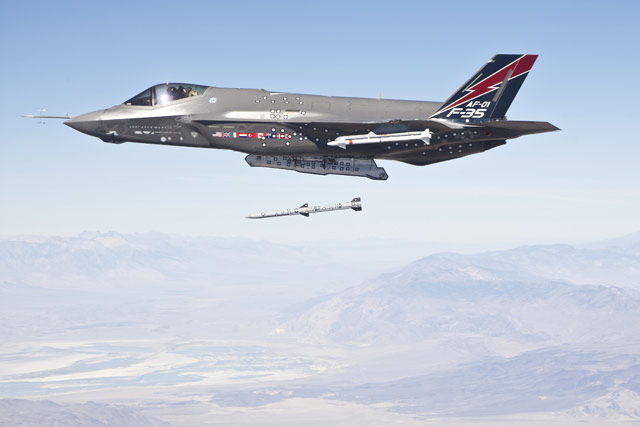The US government has awarded Lockheed Martin a $698 million contract to buy long-lead materials for 57 F-35 Joint Strike Fighters.
The contract was announced on 25 March – one day after the government’s watchdog agency reiterated doubts about the programme’s ability to reach operational readiness by target dates.
Materials to be covered by the award are for the low-rate initial production (LRIP) of 26 F-35As for the US Air Force, six F-35Bs for the US Marine Corps, two F-35Cs for the US Navy and additional aircraft for Israel, Italy, Japan, Norway and the UK. Those aircraft will be in the ninth lot of LRIP.
"This funding further demonstrates the government's commitment and the maturity of the F-35 programme," says Lockheed, which adds that 360 aircraft have been delivered or ordered through LRIP-9.
The new contract follows a report released on 24 March, in which the US Government Accountability Office (GAO) says slow progression of software testing in 2013 raises the possibility of further delays. If delays continue or funding dries up, the Department of Defense “may have to make decisions about whether to proceed with production as planned with less capable aircraft, or to alter the production rate," it says.

Lockheed Martin
Lockheed, however, says it “remains confident” it will finish software flight tests by the USMC’s initial operational capability (IOC) date, and will deliver “initial warfighting capability” to the service and the USAF as planned.
While flight testing is progressing on target, the GAO finds the programme evaluated 2,518 mission system test points in 2013 – 11% fewer than planned.
“According to programme and contractor officials, slow progress in developing, delivering and testing mission systems software continues to be the programme’s most significant risk,” the report states. Development of the Block 2B software is behind schedule, and will “likely delay the delivery of expected warfighting capabilities”, it adds.
As of January 2014, the programme verified on board functioning of 13% of Block 2B’s capability – below a 27% goal, the GAO says. It references a 2013 report from the Office of the Director of Operational Test and Evaluation, warning that development of the standard could be delayed by 13 months. That would cause a problem, because the software will provide warfighting capability not only to the USMC – the first service expected to reach that milestone – but also to the “overall F-35 programme”, it notes.
“The effects of these delays compound, [and] they also put the timely delivery of air force and navy initial operational capabilities at risk,” says the GAO.
The USMC expects to achieve IOC status with Block 2B-equipped F-35Bs in July 2015, while the USAF plans to reach the same milestone with the F-35A by August 2016, and the USN with its F-35Cs by August 2018.
USAF aircraft will have Block 3i software, which is similar to the 2B standard but works with different hardware. USN aircraft will operate with Block 3F software.
Lockheed notes that much of its 2013 testing activity focused on the pilot's helmet, which is not required this year. The company has matured the software, improved aircraft reliability and does not expect an impact from the budget cuts known as sequestration, it adds.
"We are working relentlessly to reduce this risk by tracking software development daily and fixing issues as we find them, so the military services and our international partners will receive the F-35’s full warfighting capability," Lockheed says.
Source: Flight International



















